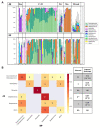Nasal Microbiome Change During and After Exacerbation in Asthmatic Children
- PMID: 35310400
- PMCID: PMC8931732
- DOI: 10.3389/fmicb.2021.833726
Nasal Microbiome Change During and After Exacerbation in Asthmatic Children
Abstract
Airway and gut microbiota are important in asthma pathogenesis. Although several studies have revealed distinct microbiota in asthmatic airways at baseline compared to healthy controls, limited studies compared microbiota during acute exacerbation (AE) and in the recovery phase (RP) in the same asthmatic children. We aim to investigate association between microbiota and asthma status in children and explore their relationship with clinical features of asthma. We recruited 56 asthmatic children and investigated their nasal, throat, and stool microbiota during AE and in the RP. Totally, 320 samples were subjected to 16S rRNA sequencing. Although the microbial communities were clearly separated by body site, within each site the overall communities during AE and in the RP could not be distinguished. Most nasal microbiota were dominated by only one or two of six bacterial genera. The domination was associated with mite allergy and patient age only during AE but not in the RP. When moving into RP, the relative abundance of Staphylococcus increased while that of Moraxella decreased. Throat and stool microbiota were not associated with most of the clinical features. Interestingly, stool microbiota during AE was associated with ABO blood type and stool microbiota in the RP was associated with frequency of the subsequent exacerbations. In summary, the association between nasal microbiota and mite allergy only during AE suggests an altered local immunity and its interplay with nasal microbes. Our work provides a basis for studying microbes, and prevention or therapeutic strategy in childhood asthma, especially during AE.
Keywords: acute exacerbation; childhood asthma; mite allergy; nasal microbiota; recovery phase.
Copyright © 2022 Liu, Lin, Chen, Jeng, Tsai, Ho, Kuo, Hsieh, Chen, Wu and Wang.
Conflict of interest statement
The authors declare that the research was conducted in the absence of any commercial or financial relationships that could be construed as a potential conflict of interest.
Figures





Similar articles
-
Temporal Dynamics of the Nasopharyngeal Microbiome and its Relationship with Childhood Asthma Exacerbation.Microbiol Spectr. 2022 Jun 29;10(3):e0012922. doi: 10.1128/spectrum.00129-22. Epub 2022 May 12. Microbiol Spectr. 2022. PMID: 35546575 Free PMC article.
-
Distinct nasal airway bacterial microbiotas differentially relate to exacerbation in pediatric patients with asthma.J Allergy Clin Immunol. 2019 Nov;144(5):1187-1197. doi: 10.1016/j.jaci.2019.05.035. Epub 2019 Jun 13. J Allergy Clin Immunol. 2019. PMID: 31201890 Free PMC article.
-
Characterization of the upper respiratory tract microbiota in Chilean asthmatic children reveals compositional, functional, and structural differences.Front Allergy. 2023 Jul 28;4:1223306. doi: 10.3389/falgy.2023.1223306. eCollection 2023. Front Allergy. 2023. PMID: 37577334 Free PMC article.
-
Association of upper airway bacterial microbiota and asthma: systematic review.Asia Pac Allergy. 2022 Jul 29;12(3):e32. doi: 10.5415/apallergy.2022.12.e32. eCollection 2022 Jul. Asia Pac Allergy. 2022. PMID: 35966153 Free PMC article. Review.
-
The Airway Microbiome and Childhood Asthma - What Is the Link?Acta Med Acad. 2020 Aug;49(2):156-163. doi: 10.5644/ama2006-124.294. Acta Med Acad. 2020. PMID: 33189121 Review.
Cited by
-
Exploring the Impact of Airway Microbiome on Asthma Morbidity: A Focus on the "Constructing a 'Eubiosis Reinstatement Therapy' for Asthma-CURE" Project.Pulm Ther. 2024 Jun;10(2):171-182. doi: 10.1007/s41030-024-00261-3. Epub 2024 May 30. Pulm Ther. 2024. PMID: 38814533 Free PMC article. Review.
-
Bacterial Microbiota of Asthmatic Children and Preschool Wheezers' Airways-What Do We Know?Microorganisms. 2023 Apr 28;11(5):1154. doi: 10.3390/microorganisms11051154. Microorganisms. 2023. PMID: 37317128 Free PMC article. Review.
-
7,8-Dihydroxyflavone attenuates the virulence of Staphylococcus aureus by inhibiting alpha-hemolysin.World J Microbiol Biotechnol. 2022 Aug 23;38(11):200. doi: 10.1007/s11274-022-03378-2. World J Microbiol Biotechnol. 2022. PMID: 35995893
-
Bacterial Proteases as Potentially Exploitable Modulators of SARS-CoV-2 Infection: Logic from the Literature, Informatics, and Inspiration from the Dog.BioTech (Basel). 2023 Oct 30;12(4):61. doi: 10.3390/biotech12040061. BioTech (Basel). 2023. PMID: 37987478 Free PMC article.
-
Nasal Microbiome and Its Interaction with the Host in Childhood Asthma.Cells. 2022 Oct 7;11(19):3155. doi: 10.3390/cells11193155. Cells. 2022. PMID: 36231116 Free PMC article. Review.
References
LinkOut - more resources
Full Text Sources

